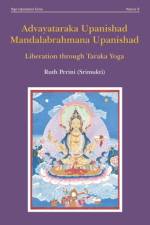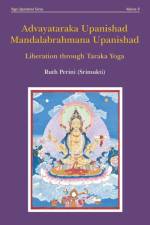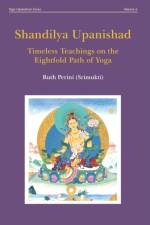- Liberation through Taraka Yoga
av Ruth Perini
239,-
Advaya-Tāraka-Upaniṣad is the upaniṣad of the non-dual (advaya) deliverer (tāraka). In the context of Taraka Yoga 'taraka' means 'ferrying one across the ocean of saṃsāra', liberation from the cycle of birth, death and rebirth, by dwelling in the radiant light of pure consciousness, which is the central theme of Vedānta philosophy, the identity of the Brahman with the innermost Self, the ātman. The text begins by listing the six spiritual qualities necessary for progress on the spiritual path. It then describes the three points of concentration (laksyas), outer, intermediate and inner, each one giving insights, signs or visual experiences. Taraka can be with or without form. Tāraka is with form when experienced through the sense of sight, and without form when ājñā cakra is awakened and a radiant light, the essential form of the nondual Reality, is seen above it. This is achieved through the practice of śāṃbhavī mudrā, nosetip gazing, and hearing praṇava, the mantra AUM.Finally the qualities of the true spiritual teacher are listed. This teacher is the one who can guide the yogin along the path to liberation, and whom the yogin experiences as a spiritual reality rather than a human personality. Maṇḍala-Brāhmaṇa-Upaniṣad, a later, more extensive version of Advaya-Tāraka-Upaniṣad. There are eighty-nine lengthy verses divided into five Brāhmaṇas, which are explanations of sacred knowledge and teachings. This work refers to the three visionary experiences (lakṣya) and the five types of 'ether-space' (ākāśa) known in tāraka-yoga. It further mentions three types of gaze (dṛṣṭi) during meditation and the importance of the nine cakras and six ādhāras. The goal is 'transmindedness' (amanaskatā), the condition of 'living liberation' (jīvan-mukti).' Āditya, the Lord of the Sun, describes the eightfold path of yoga to his disciple, the sage Yājñavalkya. Along the path are five obstacles which can be conquered by six remedies, The five obstacles on the path are sensual desire, anger, incorrect breathing, fear and sloth, which can be conquered by spiritual volition, patience and equanimity, a scant diet, concentration, truthfulness and integrity. Meditation on Tāraka, the light of yoga, is recommended, as Tāraka is the deliverer from the mundane existence of the cycle of conception, birth, life and death to sat-cit-ānanda: existence-consciousness-bliss, which are the three integral parts of Brahman, the ever-expanding consciousness, and leads to amanaska, when the mind is free from thought and desire. Meditation on Tāraka through śāmbhavī mudrā leads to praṇava, the light of pure consciousness and the primal sound vibration of AUM. Certain rituals are described which lead to dhyāna and the light of kaivalya, final liberation in the state of consciousness, where all differences are unified. The difference between suṣupti (deep sleep) and samādhi is explained. The essential qualities of a true spiritual teacher are viveka (discrimination between the permanent and impermanent), vairagya (dispassion, letting go of desire for mundane enjoyments), ṣaḍsampatti (the six virtues of equanimity, self-control, sensory withdrawal, endurance, faith and constant concentration on reality) and mumukṣutva (intense desire for liberation). By contemplating the paramātman, and living without all the senses, one attains the Supreme Reality. The mind is thus recognised as the cause of both bondage and liberation.Finally the yogin becomes an avadhūta, free from all worldly attachments or mental illusions.





